Published: 30 August 2017
Wage and salary earners' earnings almost stopped growing
According to Statistics Finland’s preliminary data, the nominal earnings of wage and salary earners rose by 0.5 per cent in the private sector during the second quarter of 2017. In the central government sector and the local government sector, the nominal earnings of wage and salary earners decreased. The drop in the public sector was caused by the cut in holiday bonuses agreed on in the Competitiveness Pact. On average, the nominal earnings of wage and salary earners rose by 0.1 per cent during the second quarter of 2017 when compared to the respective period in 2016. Real earnings fell by 0.7 per cent compared to the second quarter of the previous year.
Year-on-year changes in index of wage and salary earnings 2000/1–2017/2, per cent
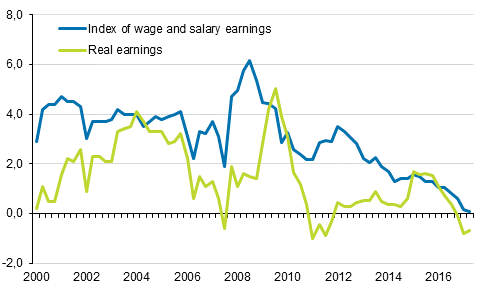
Competitiveness Pact visible in the development of public sector earnings development
According to Statistics Finland’s preliminary data, wage and salary earners’ nominal earnings rose in the private sector by 0.5 per cent from April to June 2016 to the corresponding period in 2017. In the central and local government sectors, nominal earnings fell, in the central government sector by 1.1 per cent and in the local government sector by 1.2 per cent.
The cut in holiday bonuses agreed on in the Competitiveness Pact has been taken into account in the index of wage and salary earnings and it has a negative effect on the development of the index of wage and salary earnings in the central and local government sectors starting from the first quarter of 2017. The figure examines the development of the index of wage and salary earnings in 2015 to 2017. The examination ends in the last published quarter, that is, the second quarter of 2017. The cut in the public sector holiday bonuses is visible in the development of index of wage and salary earnings in the central and local government sectors. For both, the index of wage and salary earnings falls clearly in the first quarter of 2017.
Development of the index of wage and salary earnings 2015=100 by employer sector
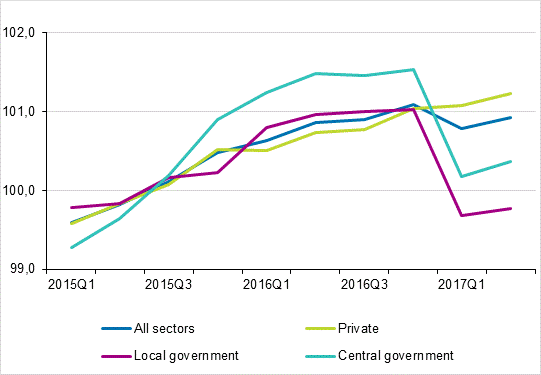
Wage and salary earners’ regular earnings increased by 0.4 per cent in April to June
The index for regular earnings describes the earning development better than the index of wage and salary earnings because it does not take into account performance-based bonuses and non-recurring items included in collective agreements. The cuts in holiday bonuses agreed on in the Competitiveness Pact are not taken into consideration in the index for regular earnings. Regular earnings rose by 0.4 per cent in April to June 2017 when compared with the respective period in 2016. They grew by 0.5 per cent in the private sector, by 0.3 per cent in the central government sector and by 0.3 per cent in local government.
According to preliminary data, earnings of wage and salary earners were 0.1 percent higher in July to September than in the year before
According to Statistics Finland’s preliminary data, the nominal earnings of wage and salary earners were 0.1 per cent higher in July to September 2017 than in July to September 2016. According to preliminary data, the index of wage and salary earnings 2015=100 for the third quarter of 2017 is 101.0. Statistics Finland compiles the preliminary third quarter data for the index of wage and salary earnings on the basis of the Employees Pensions Act (2006/395).
Earnings development varies by industry
The indices of wage and salary earnings and the indices for regular earnings are final until 2016. They are based on the realised earnings development. The indices for 2017 are preliminary and they are based on estimates of agreement effects and the wage drift.
The figure shows the percentage change in the index of wage and salary earnings on the level of main activity categories in 2005 to 2016. Earnings development has been fastest in financial intermediation and insurance activities (43.4 per cent) and in administrative and support service activities (41.0 per cent). Earnings development has been slowest in accommodation and food service activities and in manufacturing, where earnings have risen by 29.7 and 29.8 per cent, respectively, in 2005 to 2016.
Percentage change in the index of wage and salary earnings 2005=100 by industry (TOL2008) in 2005 to 2016
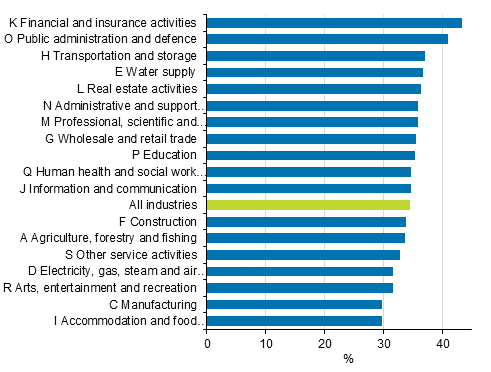
However, it should be noted that earnings development is affected by the structural change in the industry. The following section examines the effect of changes in the occupational structure on the development of average earnings. Particularly in the public sector, changes in the occupational structure have led to that the average rise in earnings has been bigger than average pay rises.
Change in occupational structure affects the development of average earnings
Statistics Finland has since 2013 published the index standardised with the main category of occupation based on the data of the index for regular earnings. In the index, the shares of the main categories of occupation for each wage and salary earner group are standardised based on the wage and salary sum weights of 2010.
The figure shows the development of the index for regular earnings and the index standardised with the main category of occupation in 2010 to 2016 in the central government sector and in the private sector. The last quarter of the year was selected to the examination and it starts from the year 2010.
Development of the index standardised with the main category of occupation and the index for regular earnings 2010=100 in 2010 to 2016 in the central government sector and in the private sector
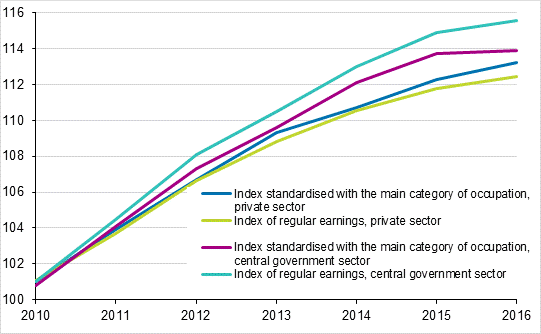
The figure shows that the development of the index standardised with the main category of occupation has been slower in the 2010s in the central government sector than the development of the index for regular earnings and this development appears to have strengthened after 2015. In the private sector, the difference between the index standardised with the main category of occupation and the index for regular earnings has not been as clear in the 2010s as in the central government sector.
In the local government sector, the index standardised with the main category of occupation and the index for regular earnings follows the same pattern as in the central government sector, that is, the development of the index standardised with the main category of occupation has been slower in the 2010s than the development of the index for regular earnings.
Professionals the biggest occupational category in central government
The development of the index standardised with the main category of occupation and the index for regular earnings in central government indicates that the rise in average earnings has been accelerated by a change in the occupational structure. The earnings level of wage and salary earners is usually higher than average in higher occupational groups. An increased share of higher occupational groups, for example, within central government, boosts the rise in earnings in the sector, while correspondingly, a decrease in the share of higher occupational groups slows down the growth in average earnings in the central government sector.
Professionals form the biggest occupational category in the central government sector. Their share of all wage and salary earners in central government has grown in the 2010s. This means that the increase in the average earnings in central government is higher than the average pay increases because the earnings level of professionals is higher than the average earnings level in the central government sector.
Share of service sale workers has grown in the private sector
In the private sector, the earnings level of service and sales workers is lower than the average earnings level. The share of monthly-paid service and sales workers among all monthly-paid private sector wage and salary earners has grown over the 2010s. In turn, this has slowed down the rise in average earnings in the private sector because the earnings level of service and sales workers is lower than the average earnings level in the private sector.
There are research data on a short period and for the private sector they do not show as clear a difference in the development of the index standardised with the main category of occupation and the index for regular earnings as for central government, for example. Based on the existing research data, no conclusions can yet be made about the long-term effects of the change in the occupational structure in the private sector.
Managers in the private and local governments sectors have fastest earnings development
The figure examines changes in earnings in 2010 to 2016 by the employer sector and the main category of occupation (managers, professionals, technicians and associate professionals, clerical support workers, service and sales workers).
Change in the earnings in 2010 to 2016 in total, by employer sector and by main categories of occupation
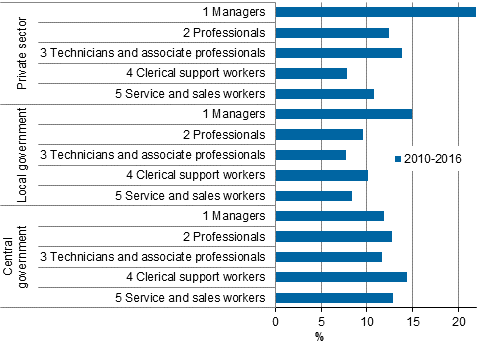
The figure shows that the earnings development has been fastest for private sector managers (21.9 per cent) in the 2010s. However, it should be noted that the top management of private sector enterprises is not included in this examination because employers do not provide Statistics Finland with these data.
In the local government sector, managers’ earnings have risen by 15 per cent and in the central government sector by 11.9 per cent from 2010 to 2016. In the public sector, the earnings development in different occupational groups has been more even than in the private sector.
Source: Index of wage and salary earnings 2017, 2nd quarter. Statistics Finland
Inquiries: Anu Uuttu 029 551 2322, Harri Nummila 029 551 3235, palkat.indeksit@stat.fi
Director in charge: Sami Saarikivi
Publication in pdf-format (499.9 kB)
- Tables
-
Tables in databases
Pick the data you need into tables, view the data as graphs, or download the data for your use.
Appendix tables
- Appendix table 1. Index of wage and salary earnings 2015=100 by employer sector and base of payment (30.8.2017)
- Appendix table 2. Index of regular earnings 2015=100 by employer sector and base of payment (30.8.2017)
- Appendix table 3. Index of wage and salary earnings 2015=100 by employer sector and gender (30.8.2017)
- Appendix table 4. Index of regular earnings 2015=100 by employer sector and gender (30.8.2017)
- Appendix table 5. Index of wage and salary earnings 2015=100 by industry, (TOL 2008) (30.8.2017)
- Appendix table 6. Index of regular earnings 2015=100 by industry, (TOL 2008) (30.8.2017)
- Appendix table 7. Index of wage and salary earnings 2010=100 by employer sector and gender (30.8.2017)
- Appendix table 8. Index of wage and salary earnings 2010=100 by industry, (TOL 2008) (30.8.2017)
- Appendix table 9. Index of wage and salary earnings 2015=100, percentage changes (30.8.2017)
- Appendix table 10. Index of regular earnings 2015=100, percentage changes (30.8.2017)
- Appendix table 11. Average earnings by employer sector and gender, EUR/month (30.8.2017)
- Revisions in these statistics
-
- Revisions in these statistics (30.8.2017)
Updated 30.08.2017
Official Statistics of Finland (OSF):
Index of wage and salary earnings [e-publication].
ISSN=1798-7814. 2nd quarter 2017. Helsinki: Statistics Finland [referred: 18.12.2025].
Access method: http://stat.fi/til/ati/2017/02/ati_2017_02_2017-08-30_tie_001_en.html

